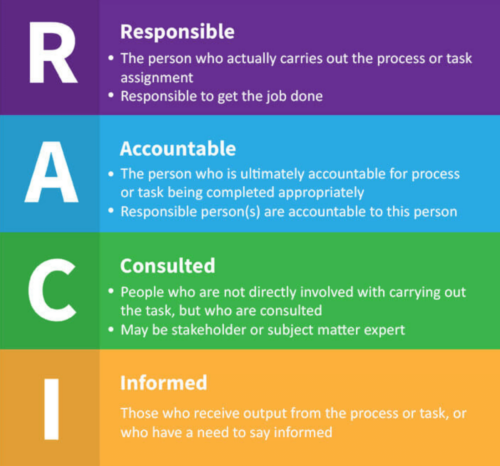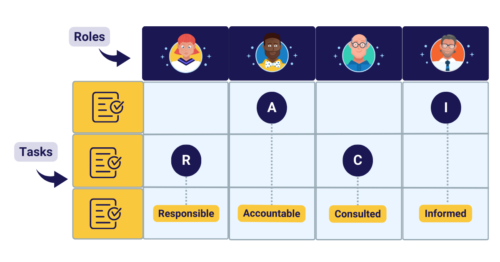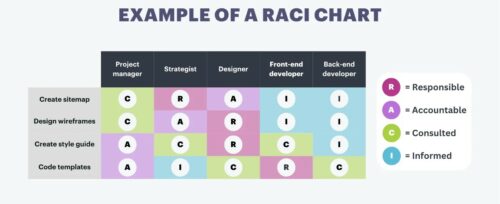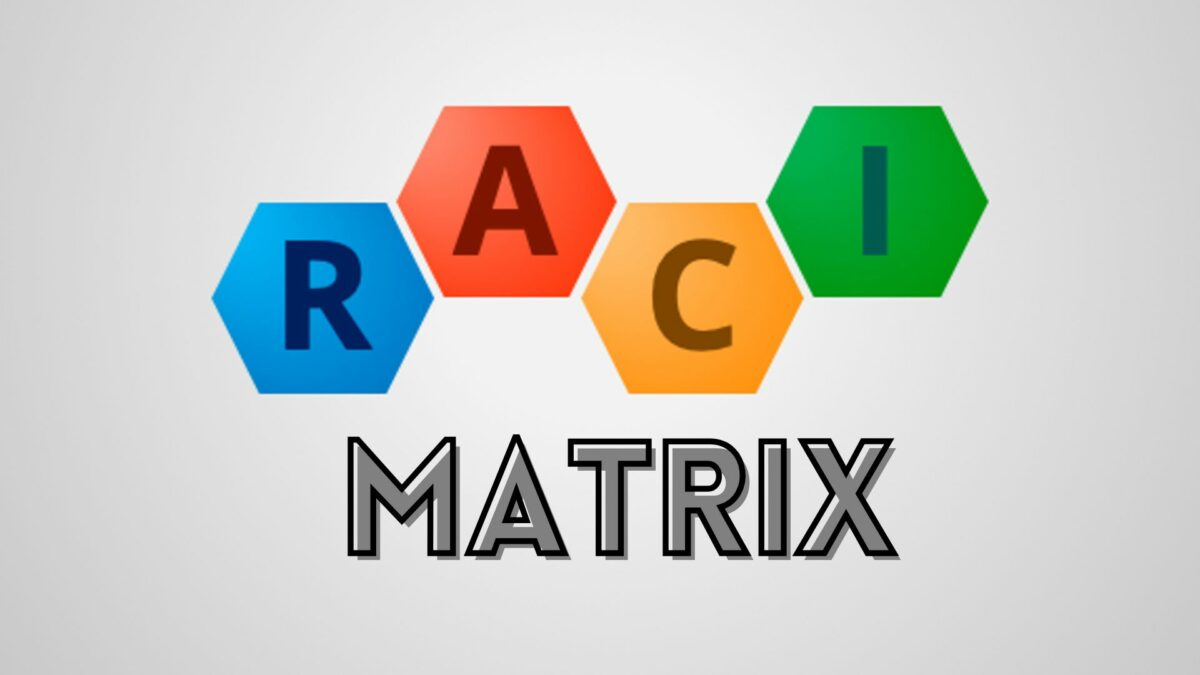What is a RACI Matrix? (Roles, Best Practices, Pros, and Cons)
Are you struggling to streamline your project’s work? Don’t worry. We are here to rescue you with one of the best management tools, “RACI matrix.” This project management tool, also known as a RACI chart, helps define and communicate the roles and responsibilities of various individuals and groups involved in a project. It’s a way to organize tasks, ensuring that all stakeholders work together towards the same goals.
If you’re looking to avoid confusion and ensure tasks are completed efficiently, a RACI matrix might just be your go-to tool. Remember, the key to a successful RACI is to have just one accountable and responsible person for each task. This helps avoid duplication of work and ensures that tasks get done without confusion. Let’s dive deeper into how you can utilize this tool to streamline your project management.
What is a RACI Matrix?

When managing complex projects, it’s essential to have clarity on everyone’s task. Well, in this, a RACI matrix can assist you. It’s not just a buzzword in project management but a valuable tool to streamline multiple tasks and roles. The term RACI stands for Responsible, Accountable, Consulted, and Informed. Here’s a quick rundown of each component:
The RACI matrix roles and responsibilities act as a communication guide, making it indispensable for a project’s success. Armed with a robust understanding of the RACI matrix meaning and its implementation, you’re now ready to navigate the complex corridors of project management with greater ease.
What Are The Roles of Acronyms R A C I?
Diving deeper into the RACI matrix and understanding the roles and responsibilities is a fundamental step. Your RACI matrix, a critical tool in project management, typically involves four types of association for a task: responsible, accountable, Consultative, and informed.
The role of the Responsible is the person who performs the task. They are the doers and have enough authority to carry out the work but they can’t make critical decisions without consulting the Accountable. In short, they are in the trenches, ensuring that the tasks are completed on time and to standard.
Moving onto the role of the Accountable, they are the ones that approve the work. This role is often filled by a higher-level manager or project leader who has the authority to sign off on the completion of tasks. According to the golden rule of RACI, there should be only one person assigned as ‘Accountable’ to ensure clear accountability.
Next are those Consulted in the process. They have the expertise required to guide the Responsible in performing the task and are often consulted prior to decisions being made. They are a valuable resource, and their input is usually sought before making any significant move.
Lastly, the Informed are those who need to know the outcome of an event or decision but they aren’t necessarily participants in the action. They are not decision-makers, yet they need to be kept in the loop as they may be affected by outcomes.
With the RACI matrix roles well defined, you’re now in a stronger position to assign tasks and responsibilities to your project team with clarity. Utilize a RACI matrix template to ease the process. Remember, it’s designed for efficiency and clarity, so use it to your advantage in effective project management.
RACI Matrix Rules and Best Practices
By now, you’ve probably noticed how it simplifies complex issues, drives businesses forward, and encourages collaboration. But what sets apart a great RACI from a merely good one? It’s all about knowing the rules and best practices, and with your foundational understanding, you’re ready to take a big step forward.
An effective RACI chart depends on an unequivocal role definition. Whether you’re using a ready-made template or charting your own course, clear delineation of who does what is crucial. Make sure to assign only one role of accountability per task – it’s one of the fundamental rules. Remember, the ‘A’ in RACI stands for ‘Accountable.’ There should be no confusion about who this person is. Plus, repurposing roles and responsibilities may seem efficient initially, but it ends up clouding accountability. Therefore, a rule that stresses assigning unique tasks to each role, no matter how small, amplifies the productive capacity of teams.
RACI matrix often emerges when used in tandem with platforms like Google Workplace, Slack, Miro, or OneDrive. These platforms further streamline workflows, allowing you to capture work, attach files directly to tasks, and interact with team members all in one place.
How To Create a RACI Matrix?

Creating a RACI matrix can organize your project’s operation. A well-crafted RACI chart clarifies task assignments, evades confusion, and minimizes overlapping work among members. You can secure a more streamlined collaborative effort with the help of a RACI template, which is especially useful if your project, like any other, involves multifaceted steps and numerous decision-makers.
To create a RACI matrix, you’ll need to define the Responsible, Accountable, Consulted, and Informed roles (R, A, C, I) within the matrix. You construct it in alignment with your project’s objectives, ensuring all responsibilities and roles are clearly outlined, leading to efficient project execution.
Make sure its fields should be flexible for adaptation to different businesses and project scopes. With this tool, you’re moving towards collaborative, efficient, and effective management, paving the path for successful project execution. Keep in mind this is just a snapshot of constructing a RACI matrix. There’s more to explore and understand about this versatile tool.
Listing every task, milestone, or deliverable is your starting line. Then, you’ll need to pinpoint the ‘RACI’ for each – the Responsible, Accountable, Consulted, and Informed individuals. Take note, each person should only have one assigned role per task in the matrix – reducing ambiguity and maintaining clarity are at the heart of what makes a RACI chart efficient.
Top Examples of RACI Charts
Continuing our exploration into RACI matrices, let’s delve into an illustrative example to get a concrete idea of what RACI matrices look like in real-life scenarios. Remember, the key concept behind a RACI matrix is to clarify roles and responsibilities within a task or project. This responsibility assignment matrix (RAM), as it’s also known, is an efficient tool when it comes to eliminating confusion. Here’s a simplified visual representation of a RACI matrix:
| Task / Role | Accountable | Responsible | Consulted | Informed
|
|---|---|---|---|---|
| Task 1 | Person A | Person B | Person C | Person D |
| Task 2 | Person D | Person A | Person B | Person C |
The Accountable person holds ultimate ownership of the task. More often than not, the Accountable and the Responsible roles may overlap, with the same person responsible for completing the task.
The Responsible party is the individual who rolls up their sleeves and gets the work done. Typically, it’s advantageous to limit the number of Responsible persons per task to avoid potential duplication of work.
Persons listed as Consulted are those whose inputs are sought, usually based on their expertise. Meanwhile, individuals categorized as Informed are simply kept in the loop about task progress but don’t actively contribute to task completion.
Adhering to these rules helps ensure that each person knows their role within the task. This cuts down on confusion and can significantly improve overall project efficiency. Implementing this effective project management strategy allows you to navigate smoothly from start to finish. Keep in mind that to maximize the benefits of this matrix, you’ll need a real-time collaborative tool, one that can assist in managing the finer project details.
RACI Matrix Template

For many organizations, especially those that are larger with numerous cross-functional teams and senior stakeholders, a saved fill-in-the-blank RACI matrix outline – otherwise known as a RACI matrix template – can be a game changer. It aids in streamlining RACI matrices across the enterprise, encouraging uniformity and cohesion. This system isn’t limited to large groups; its benefits also extend to smaller teams where each member has multiple roles. The shared knowledge through this method allows teams to solve complex issues more efficiently.
The beauty of the RACI matrix template lies in its adaptability. You may not require a template for every deliverable, but for extensive programs and organizations that frequently utilize RACI for various project types, having a template is a boon. This ready-to-use model reduces confusion, increases efficiency, and assures everyone is on the same page.
RACI Matrix Potential Pros & Cons (Must Know Before Using)
Delving into the pros and cons is as significant as understanding its basic concept, roles, and responsibilities or the rules that govern it.
Pros
- A considerable reduction in confusion regarding project roles and responsibilities.
- There’s a minimal chance of having two team members working on the same thing.
- Collaboration is made easier, and the workspace becomes less cluttered.
- Sidelines any personality clashes or office politics.
- The team will have a direct insight into their colleagues’ roles as well.
- Simplifies communication but is also a proven route to a happier team.
Cons
- An RACI chart can become outdated if changes are made to the project plan.
- Large teams may find a comprehensive RACI chart overwhelming and hard to read.
- Roles defined in a RACI might not precisely mirror.
- The tool can slow down the delivery of specific tasks.
Conclusion
The RACI Matrix can be a game-changer in your project management toolkit. It’s a powerful tool that can clear up confusion, foster better team collaboration, and cut down on office politics. But it’s not a one-size-fits-all solution. You’ll need to stay vigilant about keeping it updated and ensuring it accurately reflects the roles and responsibilities within your team, especially when you’re dealing with larger groups. Using the RACI effectively requires a thoughtful approach, but when done right, it can significantly boost your team’s productivity and overall happiness. Remember, it’s all about finding what works best for your team and your project.
Frequently Asked Questions
1. Why should I be cautious about using the RACI chart in specific organizations?
Organizations with bureaucratic or low-trust cultures may misuse the RACI Matrix. In these settings, shortcomings include lack of accountability, rampant silos, top-down micromanagement, and overall reduced competence levels.
2. What are the drawbacks of the RACI Matrix?
One significant disadvantage of the RACI Matrix is the potential for confusion or misinterpretation among team members. This confusion can lead to misunderstandings about roles, causing potential delays, conflicts, and a decline in team morale.
3. Can there be multiple accountable individuals in a RACI chart?
Ideally, having only one responsible and accountable person is recommended. By assigning more than one person to a given task, it increases the likelihood of ambiguity and tasks left undone.
4. What does the acronym RACI stand for?
RACI stands for Responsible, Accountable, Consulted, and Informed. The acronym defines the level of ownership each individual has over a certain task in a project.
5. How does Responsible differ from Accountable in the RACI model?
In the RACI model, Responsible (R) signifies the person who executes the task, whereas Accountable (A) refers to the party owning the task and the resulting outcome.

Leave a Reply